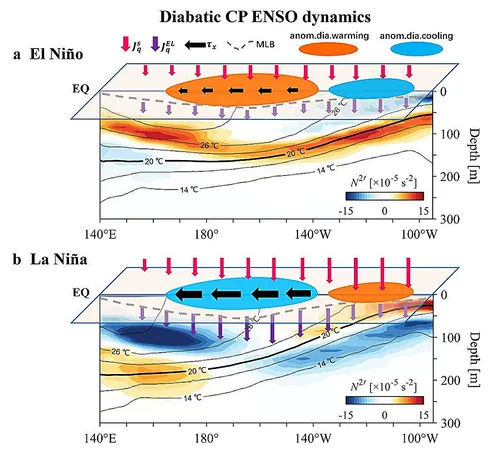
Breaking: New Study Unveils How Ocean Mixing Powers Central Pacific El Niño Phenomena!
2025-04-03
Author: Li
Study Overview
A groundbreaking study has revealed critical insights into the El Niño and Southern Oscillation (ENSO), one of the most powerful climate phenomena affecting weather worldwide, particularly across the Asia-Pacific region. Accurate predictions of ENSO are vital for climate forecasting, but experts are alarmed by a notable decline in predictive skill observed since the start of the 21st century. This decline appears linked to increased activity in the central Pacific (CP), diverging from the traditional eastern Pacific (EP) influences seen in previous years.
Research Team and Methodology
Led by Prof. Wang Fan from the esteemed Institute of Oceanology of the Chinese Academy of Sciences, a dedicated research team embarked on a mission to unravel this dramatic shift by investigating the effects of subsurface ocean mixing on ENSO dynamics. Their remarkable findings, just published in Nature Communications, highlight a crucial diabatic feedback mechanism that not only intensifies CP El Niño events but also suppresses those occurring in the eastern Pacific.
Data Collection and Analysis
Employing an innovative estimation method that leverages extensive long-term data from over 40,000 Argo profiles across the equatorial Pacific Ocean, the researchers constructed the most comprehensive dataset on subsurface mixing to date. This extensive analysis underscored the vital role of ocean subsurface mixing and turbulent heat flux in fostering growth for both El Niño and La Niña phenomena associated with the central Pacific.
Key Findings
One of the most significant revelations of the study is the relationship between subsurface mixing and surface temperature dynamics. The research indicates that the divergence of heat flux entering and exiting the mixed layer of the ocean creates pronounced warming effects in the central Pacific. In stark contrast, similar processes were found to cool temperatures in the eastern Pacific region, disrupting its ability to support El Niño phenomena.
The Feedback Loop
Even more intriguing is the self-reinforcing nature of this feedback loop. The conditions fostered by CP El Niño, such as wind patterns and ocean thermal structure, amplify the intensity of subsurface mixing, further escalating the CP El Niño events—a dynamic that exceeds the influence of other known climate mechanisms.
Quote from the Lead Author
Dr. Liu Chuanyu, the lead author of the study, aptly noted, "This positive feedback continues to persist until counteracting negative feedback mechanisms eventually take command."
Implications
These fresh insights shed new light on ENSO mechanisms, particularly emphasizing diabatic processes. In contrast to traditional models that primarily focus on either positive or negative feedback routes, this study introduces an essential perspective that could reshape how scientists approach ENSO predictions and climate forecasting moving forward.
Conclusion
With the ongoing threats of climate change, understanding these complex ocean-atmospheric interactions has never been more critical. This research is a significant step toward more reliable climate forecasts, ensuring communities and nations can better prepare for the rolls of nature that shape our future.


 Brasil (PT)
Brasil (PT)
 Canada (EN)
Canada (EN)
 Chile (ES)
Chile (ES)
 Česko (CS)
Česko (CS)
 대한민국 (KO)
대한민국 (KO)
 España (ES)
España (ES)
 France (FR)
France (FR)
 Hong Kong (EN)
Hong Kong (EN)
 Italia (IT)
Italia (IT)
 日本 (JA)
日本 (JA)
 Magyarország (HU)
Magyarország (HU)
 Norge (NO)
Norge (NO)
 Polska (PL)
Polska (PL)
 Schweiz (DE)
Schweiz (DE)
 Singapore (EN)
Singapore (EN)
 Sverige (SV)
Sverige (SV)
 Suomi (FI)
Suomi (FI)
 Türkiye (TR)
Türkiye (TR)
 الإمارات العربية المتحدة (AR)
الإمارات العربية المتحدة (AR)